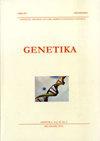旱作和热胁迫条件下春小麦生理性状的遗传分析及标记关联
4区 农林科学
Q3 Agricultural and Biological Sciences
引用次数: 0
摘要
确定与小麦生理性状相关的基因相互作用和标记,特别是在灌浆后期,有助于制定有效的育种方法。对4个不同春小麦杂交组合(干旱敏感×干旱敏感)的6代(P1、P2、F1、F2、BC1P1和BC1P2)和单个杂交组合(MACS6272 × UP2828)的F3代进行表型分型和基因分型,分析基因作用和相关标记。6代间,冠层温度降(CTD - 2.6 ~ 5.6℃)、SPAD叶绿素含量(39.6 ~ 51.3)、相对含水量(RWC - 51.5 ~ 75.4%)、籽粒灌浆期(GFP - 61.1 ~ 80.1 d)、百粒重(3.7 ~ 5.5 g)、收获指数(HI - 25.8 ~ 46.2%)、单株生物产量(by - 35.5 ~ 89.8 g)和籽粒产量(GY - 13.4 ~ 36.5 g)均发生了较大变化。GY与CTD、SPAD、100SW、BY、HI呈正相关(0.08* ~ 0.85**)。通过其他性状对光合速率的直接影响最大(0.82),间接影响最大。除GFP和100SW外,其余性状均存在显著的非加性上位相互作用(j & l)和重复基因作用。与CTD、SPAD、NDVI、RWC、100SW相关的7个SSR标记解释的表型变异(PVE)范围为10.1% ~ 18.4%,其中Xcfd35标记解释的表型变异(PVE)最高。所鉴定的候选基因属于跨膜蛋白(Xcfd32, Xcfd50),核酸结合域(Xbarc124, Xgwm484)和具有非生物抗性重要的酶活性(Xcfd35, Xwmc47, Xwmc728)。6代的复杂遗传表明,选择推迟到分离的后期,从而可以选择有用的越界分离来提高小麦的产量。本文章由计算机程序翻译,如有差异,请以英文原文为准。
Genetic analysis and marker association of physiological traits under rainfed and heat stress conditions in spring wheat (Triticum aestivum L.)
Identifying gene interactions and markers associated with physiological traits, especially at later stages of grain filling, can help develop effective breeding methodology in wheat crop. Six generations (P1, P2, F1, F2, BC1P1 and BC1P2) of four different spring wheat crosses (drought-responsive x drought susceptible) and F3 generation of a single cross, i.e., MACS6272 x UP2828 were phenotyped and genotyped to decipher gene action and associated markers. Ample variation in canopy temperature depression (CTD - 2.6 - 5.6?C), chlorophyll content by SPAD (39.6 - 51.3), relative water content (RWC - 51.5 - 75.4 %), grain filling period (GFP - 61.1 - 80.1 days), 100 seed weight (3.7 - 5.5 grams), harvest index (HI - 25.8 - 46.2 %), biological yield (BY - 35.5 - 89.8 grams) and grain yield (GY - 13.4 - 36.5 grams) per plant were observed in six generations. GY positively correlated with CTD, SPAD, 100SW, BY and HI (0.08* - 0.85**). BY had the maximum direct (0.82) and indirect effect via other traits on GY. Significant non-additive epistatic interactions (j & l) and duplicate gene action were found for most traits except GFP and 100SW. Seven different SSR markers associated with CTD, SPAD, NDVI, RWC, 100SW, and explained phenotypic variation (PVE) ranging from 10.1% to 18.4%, with marker Xcfd35 explaining highest PVE for RWC. The identified candidate genes (in silico) belonged to transmembrane proteins (Xcfd32, Xcfd50), nucleic acid binding domains (Xbarc124, Xgwm484) and having enzymatic activity (Xcfd35, Xwmc47, Xwmc728) important for abiotic stress tolerance. Complex inheritance deciphered by six generations indicated delaying the selection to later stages of segregation so that useful transgressive segregants can be selected for improving grain yields in wheat.
求助全文
通过发布文献求助,成功后即可免费获取论文全文。
去求助
来源期刊

Genetika-Belgrade
AGRONOMY-GENETICS & HEREDITY
CiteScore
1.80
自引率
0.00%
发文量
1
审稿时长
6-12 weeks
期刊介绍:
The GENETIKA is dedicated to genetic studies of all organisms including genetics of microorganisms, plant genetics, animal genetics, human genetics, molecular genetics, genomics, functional genomics, plant and animal breeding, population and evolutionary genetics, mutagenesis and genotoxicology and biotechnology.
 求助内容:
求助内容: 应助结果提醒方式:
应助结果提醒方式:


